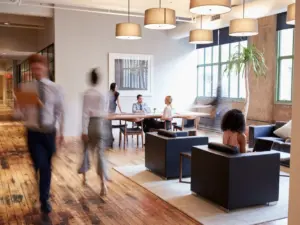

Greater London has 21.6 million square metres of office space, an area more than ten times the size of Monaco. Between January and April 2020, more than half of the people using this space moved to working from home. The Covid-19 pandemic has forced employers and employees to rethink the previously accepted norms of their working lives, and to question what is meant when we say we look forward to a return to “business as usual”.
What seems clear is that working from home, working from anywhere, and hybrid working models are the future for whole workforces that previously worked almost exclusively in large offices. The IFS found in May 2020 that 58% of London’s workers were in occupations amenable to working from home. When the Institute of Directors surveyed nearly 1,000 company directors six months later, they found that 74% intended to maintain increased home working after the pandemic.
It looks as if this trend will be supported wholeheartedly by workers themselves. Studies conducted before the pandemic showed that working from home boosts productivity, and the Gensler UK workplace survey 2020 found that most people want to use a hybrid model.
Companies are already acting on this. Capita, the outsourcing group that runs the London congestion charge, will close 100 of its 250 offices. Price Waterhouse Coopers and the fund manager Schroders are to allow the majority of staff to continue to work from home. NatWest Group, owner of Royal Bank of Scotland, has told 49,000 of its 65,000 staff to keep working from home.
Offices are the biggest component of city centres. What happens if they are no longer needed? And will the office go down without a fight?
The future of the workforce
Before the pandemic, more progressive companies had already begun to experiment with the ways in which greater flexibility for employees leads to benefits such as productivity and staff retention for businesses. The ability to blur the boundaries between work and social life has long been recognised as working in a company’s favour.
But for those who own commercial property, Covid-19 catalysed a disturbing trend. Lockdown caused an immediate reduction in rents and a short-term loss of income as the economy stalled, but it is the long-term picture that worries the developers, consultants, property agents and politicians who continue to espouse anecdotal myths about a return to “business as usual”. The unused office space in the UK now adds up to nearly five and a half million square metres, representing a vacancy rate of 4.5%.
A recovery in demand for office space in the capital and other cities is being talked up, and the incentives to do so are clear: 2.5 million square metres of refurbishments and new developments are scheduled for completion in London alone over the next four years and the majority (more than 80%) of this investment is speculative, without tenants.
Some companies, too, have a stake in a return to office work. The Goldman Sachs CEO, David Solomon, argued recently that WFH was an “aberration” and “not a new normal” for the bank, despite the fact that Goldman UK has operated successfully over the past year with only 10% of its workforce in the office. Perhaps a more significant motivation for Solomon’s comments was the 25-year lease it recently signed on an enormous new HQ in Farringdon, built to bring all 6,500 London staff under one roof. Goldman trades on its expertise in reading markets and understanding trends; to invest in such a massive physical presence and not use it could look like a failure to understand the future.
For most people, working in an office will bear very little resemblance to working at Goldman Sachs, nor will the rewards for doing so be nearly so seductive. But many employers still share Solomon’s reluctance to adopt working from home, perhaps because they conflate attendance with control.
For the growing millennial workforce in particular, this creates a sense of insecurity that being out of sight, and out of mind, could translate into a diminution of their career prospects. This has not been helped by baseless government threats that home workers will “find themselves in the most vulnerable position” when companies restructure themselves.
What is sadly missing from this debate is a proper discussion of the fundamental problem with offices and the divisions and inequality that they engender, from the boardroom to the hot desk. These are issues that existed long before the pandemic, but which alternative working practices have brought into sharp relief.
Step away from the offices of yesterday
The contemporary office has been described by one speculative developer as a “white-collar factory”. This description is cynical but accurate. In many respects, offices now exist as production lines for information products. As with factories that create physical products, such as smartphones or bread, the operative labour generally does not own any share of the building in which it works or the enterprise itself. Machinery, buildings and materials are provided by the owners and the resulting profit (or losses) belong to the owners.
The serried ranks of white-collar labourers who are expected to sit for at least 40 hours a week in such offices have experienced a decline in real wages that has lasted over a decade. In return, they have been hoodwinked by benefits in kind: offices with tea and coffee, cycle parking, showers and gyms, or curated social activities such as team sports, yoga, choirs or life drawing.
These enticements are a good thing, but compare them to those offered by the likes of George Cadbury to his factory workers in Bournville in the late 19th century, who enjoyed free housing (the largest expense for almost all workers) and healthcare. Cadbury offered his staff night classes, swimming pools, outings, summer camps, kitchens, gardens and sports fields.
What should concern modern business owners and managers is not their ability to monitor their workers but the cost incurred by the drudgery and tedium of office life, as well as the excessive cost of attending an office. The average commute time across the UK is around an hour a day, and very few employees are reimbursed by their employer for their travel. Commuting is the single biggest source of carbon emissions (not to mention other pollutants) in the UK, while the cement used to build offices (and other buildings? The built environment accounts for approx 40% of UK Total Carbon Footprint, half being attributable to energy in use) accounts for 8% of global CO2. And this is before the buildings are powered, lit, heated, cooled or cleaned.
Doing workspaces well
What will replace the office? Recent studies show a growing interest in “hub and spoke” arrangements, in which a smaller central office is complemented by distributed home working or co-working. There are still many aspects of work for which an office is best: meeting, mentoring, socialising and collaborating. Such offices will need to provide more flexibility for groups to meet, from one-on-one meetings to client presentations, training or full-company presentations and functions.
Amenities to improve wellness and well-being are also high on the list, but the offices of the future may also need to think about overnight accommodation if staff have moved to another part of the country and are spending two days a week in the main hub.
Such wholesale reimagining could bring exciting change to the physical world of work, but they will face significant challenges, especially from the planning authorities and their adherence to inflexible use-class designations. But even this is beginning to shift, with more enlightened boroughs and authorities realising that change is inevitable.
It is still too early to say if such a radical work/lifestyle change will emerge from the adversity we have faced over the past 12 months, but surely we should all hope for such a positive outcome, where the greatest benefit accrues to the greatest number.
This article originally appeared on NewStatesman.com.






